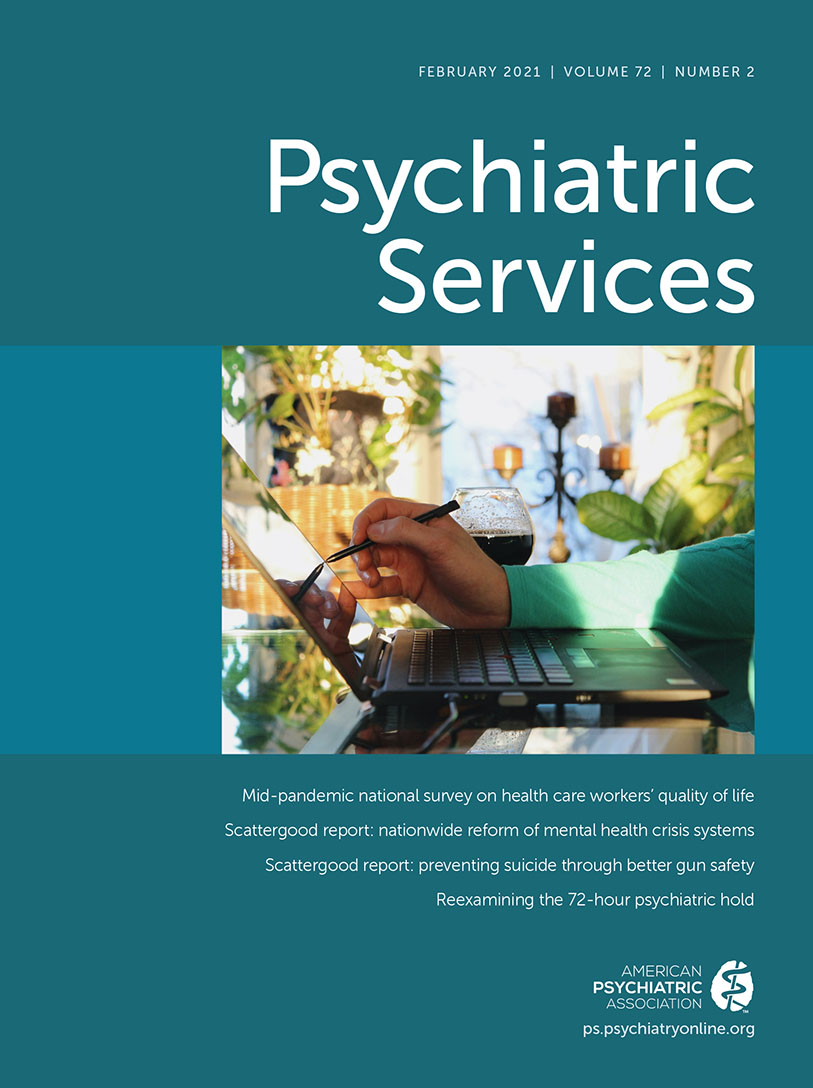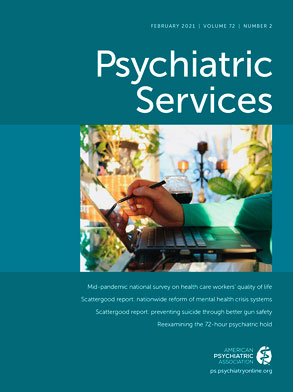Service user engagement is an important element in facilitating mental health recovery. One aspect of service user engagement, advance care planning, has become a feature in mental health systems worldwide (
1). Although its form may vary, the key concept is that health care decision making is shared between consumers and providers (
1,
2). New Zealand’s 2018 review of mental health and addiction services (
3) emphasized the need for consumer-centric and rights-based initiatives and recommended revised mental health legislation to incorporate the use of psychiatric advance directives (PADs). Unlike medical advance directives, which focus on end-of-life care and withholding treatment, PADs allow service users to express preferences that support their autonomy and provide them a voice in their care choices when they may not have the capacity to give informed consent (
4).
Despite acceptance of PADs among service users and providers, there is little confidence among service users that they have the right information or support to collaborate in their care planning for future mental health crises, and providers are not convinced that choices made by service users in PADs will be consistent with the provider’s perceived duty of care (
5–
7). In practice, few service users create PADs (
8). In a systematic review and narrative analysis of the topic, Shields and colleagues (
9) identified several barriers to PAD creation and implementation. Various stakeholders reported differing barriers, and applicable laws led to country-specific differences. It is our experience in New Zealand that although many of these barriers are relevant, several factors can substantially facilitate creation of PADs by service users and improve acceptance and implementation of these documents by clinicians.
Mental health treatment in New Zealand is almost entirely publicly funded. However, although New Zealand has only 4.8 million residents, there are 20 district health boards, each with its own systems for local implementation of health initiatives. New Zealand’s current Mental Health Act does not specifically mention PADs. The Code of Health and Disability Consumers’ Rights refers to the right of all consumers to have an advance directive, but consumers under compulsory treatment orders can have their PADs overridden, by power of the Mental Health Act, if the treating psychiatrist deems the PAD’s provisions not to be in the person’s best interests. PADs differ from advance care plans (ACPs), which focus primarily on end-of-life care issues and on consumers with chronic or severe general medical illnesses. The New Zealand Health Quality and Safety Commission has a website (
www.hqsc.govt.nz/our-programmes/advance-care-planning) advocating the use of ACPs for general medical care, but it includes no discussion of their use in mental health care. In our earlier work (
2), mental health consumers and their families reported that the current ACP format does not address their needs.
In this Open Forum, we summarize our experience working with mental health service users, clinicians, and support workers to create and implement PADs, focusing on factors that help or hinder this process. Our experience arose from a PAD implementation project (
2) in the Mental Health, Addictions, and Intellectual Disability Services of New Zealand’s Southern District Health Board (SDHB).
PAD Completion
In the 10 years prior to our initiative, which began in 2018 and is ongoing, only 16 mental health service users in the SDHB had medical files that contained an advance directive alert, and a majority of these signaled merely that an enduring power of attorney (i.e., a decision maker designated by a person when competent to make decisions regarding their health care if they later become incompetent) was in force, not that a separate PAD had been created by the service user. In 2019, approximately 5,000 people between the ages of 15 and 75 were registered as clients of the SDHB’s mental health services. In the 12 months since we commenced our initiative, 60 service users in the SDHB’s region have created PADs (
4). This result suggests that about 1% of the target population of mental health service users created a PAD in 2019 as a result of our initiative. Completed PADs varied in the amount of information presented, but much of the content was aimed at providing information on consumers’ positive preferences, rather than on what they did not want to occur (
6). Therefore, the completed PAD documents generally demonstrated consumers’ willingness to use their PADs to assist them in engaging in treatment, rather than to oppose treatment (
2,
7).
Barriers to Completion
Shields and colleagues (
9) summarized factors that may hinder creation of PADs. We found that all barriers identified in Shields and colleagues’ meta-analysis, except for potential legal lability should a clinician override a PAD, were raised in the focus groups and online surveys that informed the development of our PAD process or in our discussions with service users, support workers, and clinicians. In addition, we noted further barriers, namely, absence of an established PAD process or PAD template and lack of suggestions or prompts to the service user regarding items to include in the PAD.
An extensive literature reports on barriers to completion of PADs (
9). These barriers include lack of a defined process for creating a PAD (
4), information imbalances and communication difficulties between service users and clinical staff (
5,
7), and pessimism about the usefulness of the PAD process and the value of its likely outcomes (
5,
10). Henderson et al. (
11) reported little consensus between clinicians and consumers on where PADs should be completed and who should help facilitate the process. Although we anticipated that consumers would prefer assistance with completing the PAD from peer support workers, who are individuals with lived experience who engage with service users, rather than from clinicians, our work has shown that more consumers have completed their PADs with their caseworkers (primarily nurses) than with any other group.
Previous research has shown that even when psychiatric PADs are completed, without an accessible and secure central registry to allow for easy retrieval of the document in a crisis, the process was reported to be generally futile (
12). Although the procedure we implemented allows completed PADs to be accessed electronically and alerts those accessing the service user’s electronic medical record of the PAD’s presence as soon as the file is opened, it remains possible that the document will not be fully accessed or followed by clinicians. Further research is needed to determine clinicians’ and service users’ experiences with PADs and the frequency with which PADs are referred to in practice.
Facilitating Factors
Facilitators of PAD use at a health system level included having health care workers who acted as “champions” for the PAD process. In our case these were a senior nurse leader and key nurses on various community mental health teams (CMHTs). It was also important to organize outreach meetings. We held separate meetings for relevant health care professionals (e.g., CMHT members, general practitioners), support organizations (e.g. nongovernmental organizations offering day programs and outreach support for mental health service users), and service users and their families and supporters. Health board information technology support was essential for PADs to be uploaded into service users’ electronic medical files and for creating electronic alerts to identify the presence of a PAD when a patient’s file was accessed. Targeted education and training also helped provide health care professionals with the tools to support the creation and use of PADs, to address negative attitudes about PADs, and to assist service users in making decisions about future care. For service users, lack of knowledge about PADs and negative attitudes toward them could be managed through education. Having support from a trusted person to create a PAD was important to service users. Most of the PADs made were created in conjunction with a mental health nurse or other clinician, although the service users also considered peer support workers to be helpful.
In contrast to the extensive literature on barriers to PAD completion (
9), the literature on facilitators of PAD completion is surprisingly small. Kemp et al. (
12) identified the importance of having an organizational champion to manage institutional inertia or cultural difficulties in creating and implementing PADs. The findings from our current initiative validate the Kemp et al. findings; the use of PADs was supported at the policy level by a senior nurse leader and by a consumer researcher who participated in the education sessions and at the operational level by champions within the clinical teams. Kisely et al. (
13) showed that staff training increased patient input into planning for future crisis management. Borschmann et al. (
14) emphasized the importance of psychoeducation to manage negative or pessimistic attitudes about PADs among service users and health care professionals and reported improved clinical relationships between service users and providers as well as improved feelings of control by service users. Bee et al. (
5) highlighted the importance of health professionals’ improvement in fundamental listening and engagement skills when working with service users in mental health care planning and promoting shared decision making. Similarly, we found that clinicians responded well to training workshops that introduced the PAD instrument and presented the research behind its development. The importance of supporting consumers in completing PADs has been identified in several publications (
8,
11,
15); however, disagreement remains about whether input from clinicians or patient advocates has led to more detailed PADs. Although more than half of the individuals in our sample completed their PAD in conjunction with a clinician, many others completed the document with the help of a peer support worker (
4). The most important factor appeared to be that individuals creating PADs do so with the help of someone whom they trust and with whom they feel comfortable.
Conclusions
We have presented a number of factors that may facilitate completion of PADs by mental health service users. If, as seems likely, PADs are included in revised mental health legislation in New Zealand, their use will become a national priority. Our observations may help overcome barriers to completion of PADs and assist with rates of PAD completion.

